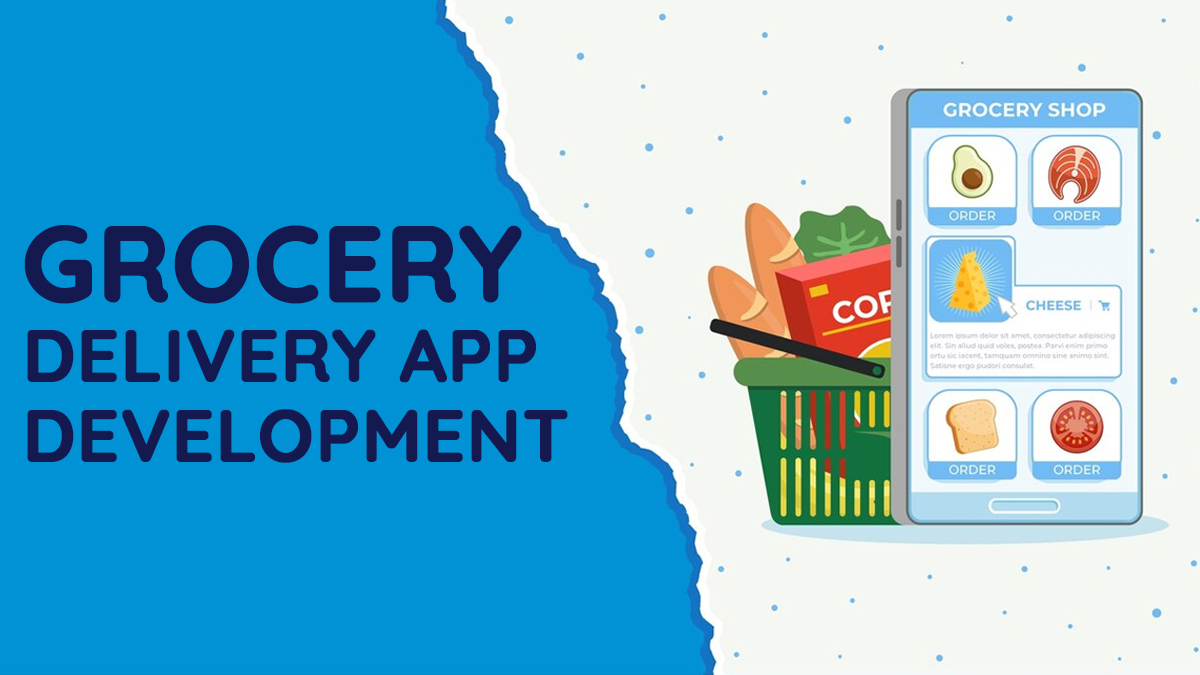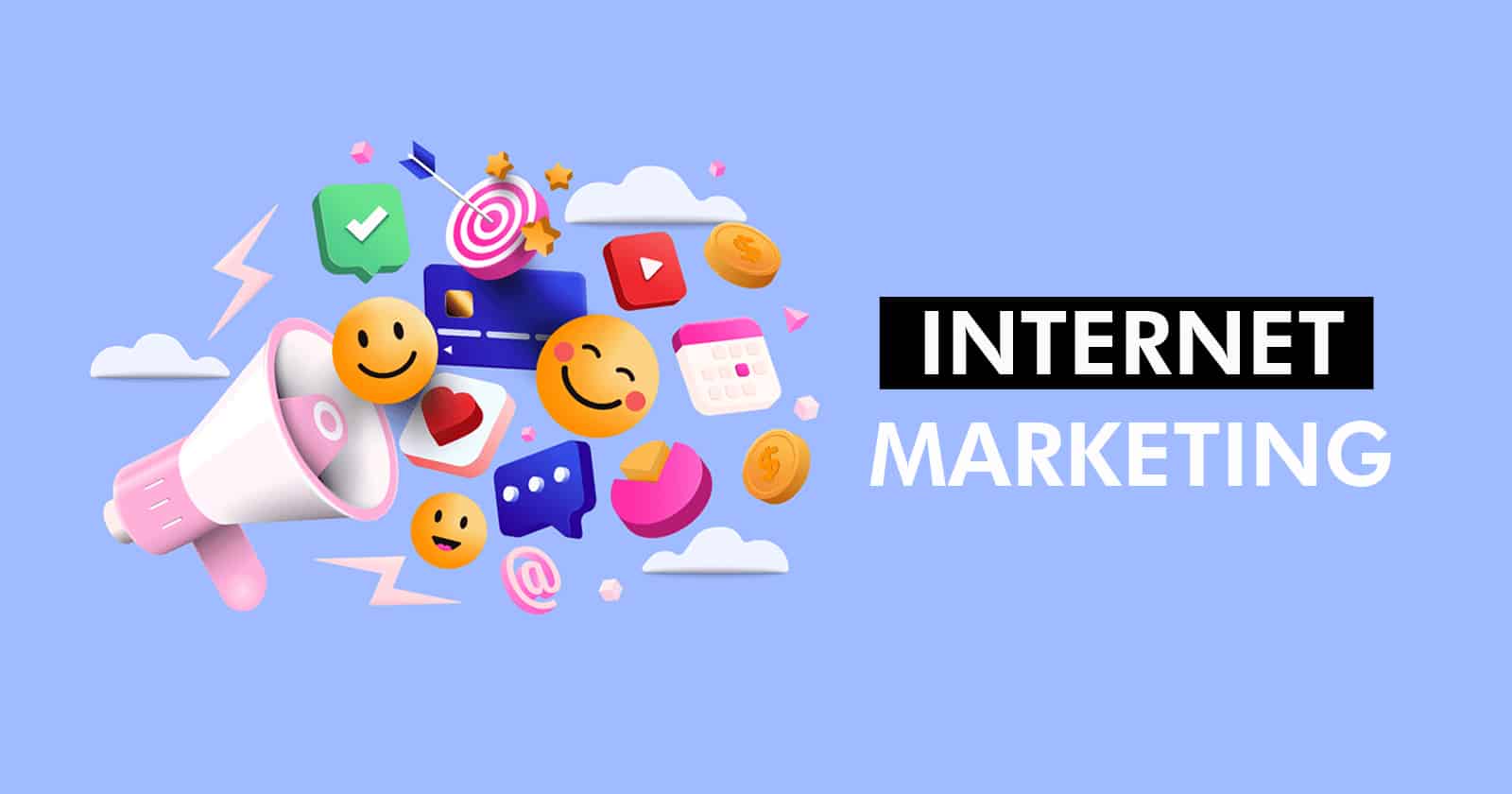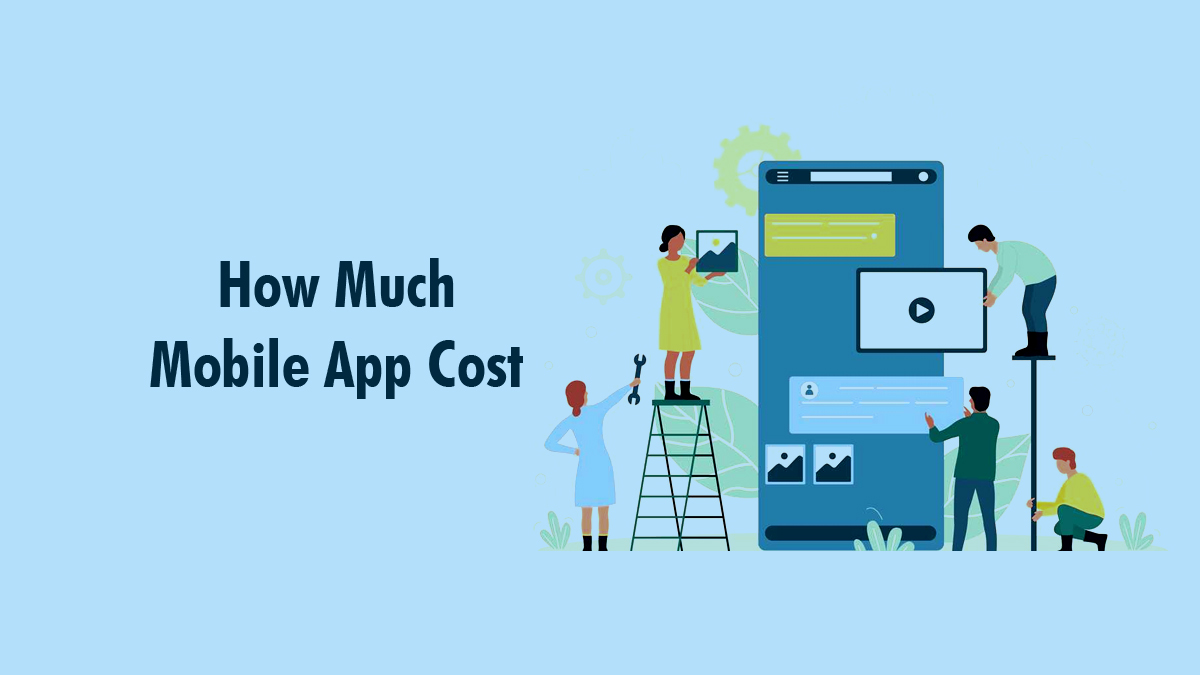In 2024, making a grocery delivery app could be a good way to make money. Everything is online now, older people are also shopping online like everyone else. With an easy-to-use app, shopping for groceries is no longer a difficult job. Instead, it’s a quick task that you can finish in just a few minutes.
According to Statista, 58% of young shoppers in the UK prefer to buy their groceries online. By 2025, the average amount that people in the US spend on online groceries each year will go up to $1,524.84 from $856.47 in 2021.
As more people are buying groceries online, it’s really important to make easy-to-use grocery delivery apps with great features. In this post, we will look at everything you need to know about grocery delivery app development.
What is a Grocery Delivery App?
It is an app that lets you purchase groceries from your home, similar to an online store, but with faster delivery. You can look at all the things a store has on a website, choose what you want, pay on the website, and then it will be delivered to your house. Today’s grocery delivery apps do more than just the basic functions. They also have GPS order tracking and personalized features that use AI and machine learning.
Selecting the right app development service provider is crucial for the success of your grocery delivery app. Look for a partner with a proven track record in app development and a deep understanding of the grocery market.
Can a Grocery Delivery App Make Money?
Grocery delivery apps help people to order groceries or other items and have them delivered to their house. There are lots of websites and apps for ordering food. So, why can developing an app for delivering groceries be a good way to make money? Here are three reasons.
Investing Money in a Business That is Growing Quickly
More and more people want groceries delivered to their homes. According to Statista, the grocery delivery market worldwide is expected to grow to $1,271 billion by 2028. This means it will increase by 12.74% each year from 2024 to 2028.
Furthermore, The Business Research Company says that the online food delivery market is growing because more people are working, especially young people in big cities. As more people work in big cities, have more money to spend, and use the internet, the need for food delivery will keep increasing.
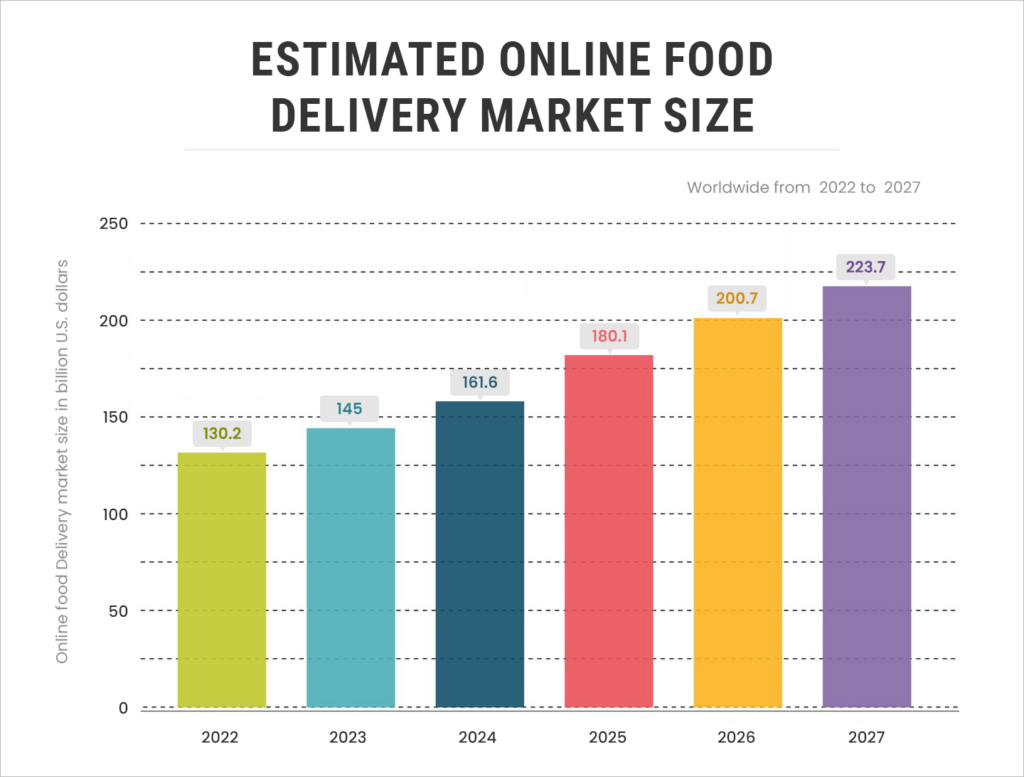
Making Grocery Shopping Experience Better
Buying groceries online and having it brought to you is obviously quicker than going to the store in person. On the app, you don’t need to spend time looking for the right products and waiting in lines.
And not having to deal with a difficult situation is a big advantage for people who work long hours. In stores, customers can only pay with a credit or debit card. But with apps, there are more ways to pay like using RFID cards and EMI options.
Simply put, online grocery shopping makes life easier for customers, so they will keep choosing it over going to physical stores.
Creating Better Relationships With Your Customers
If you want to create an app for delivering groceries, you are probably a grocery store owner, own a chain of stores, or are an entrepreneur looking to work with other stores. If you want to have regular customers, it’s a good idea to use an app for your business. This can help you keep people coming back, because:
- The opportunity to make their experience better with your service
- You can understand how customers behave and suggest things they might like by looking at what they have bought before
- The tools help to look at each part of a customer’s experience, like when they buy things at certain times of the year, what kind of packaging they like, and why they don’t want certain products
With this information, you can make a plan to reach out to your customers and make more money. For example, if the person usually buys a certain type of item, tell them when it’s on sale with a message, or recommend other options if it’s not available.
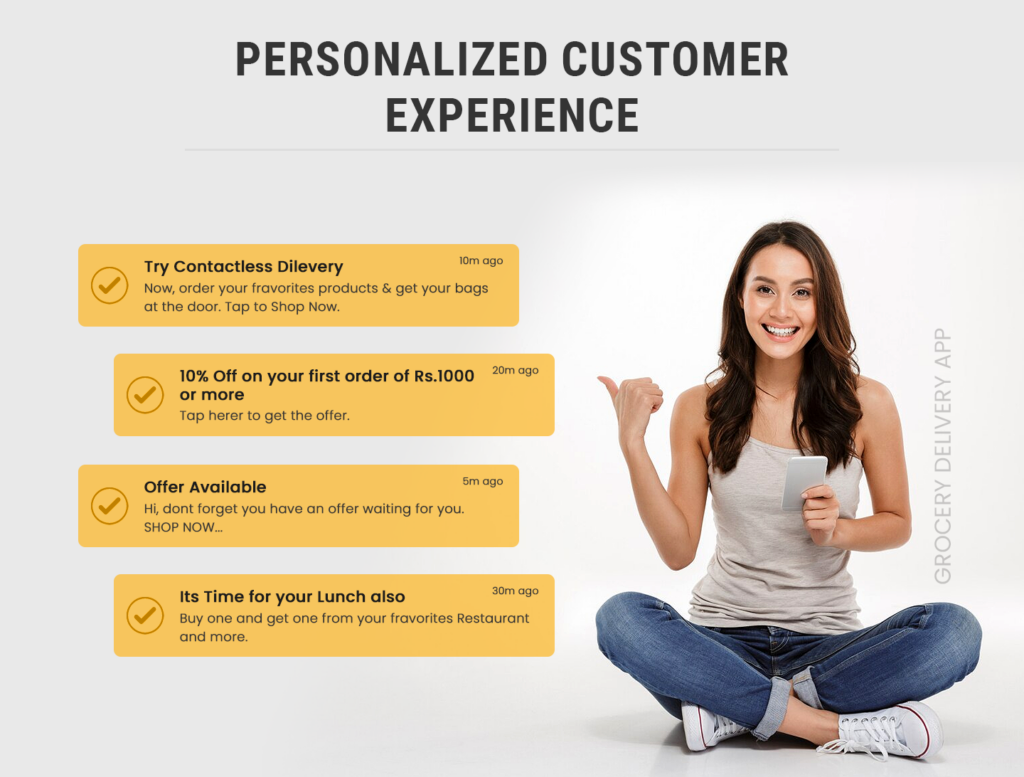
Alternatively, you could provide packaging that can break down naturally. Why not tell our regular customers who buy eco-friendly products more about them? Also, you can create a system for giving rewards in the app, such as:
- Get money back when they make a purchase
- Reward programs for being a loyal customer
- Coupons for deliveries without charge
- Everyday and occasional special offers
Making small and smart decisions when creating a grocery app can make customers feel really connected and loyal to your app.
Also Read: Earn Big in 2024: 50 Mobile App Ideas Unveiled
How to Select the Right Type of Grocery Delivery App?
Before you start creating and building your on-demand delivery service, it’s important to figure out how your business will make money. The app’s future features and how it’s built will be decided by this choice.
Choosing the right model at the beginning saves money because you won’t need to make big changes to the app later. A grocery shop app can use two different ways to deliver orders when customers order them:
- The delivery company has a store where they own the items they deliver
- The delivery company works with many stores and brings their items to people’s homes
Walmart has its own app and it offers a delivery service, but not everyone can use it. Other stores work with services to have them deliver their products. By working together with a store, you can use its products and prices for your app. There are many ways to use this technology.
You have the option to skip the partnership and just deliver products whenever they are requested without saying which store they are from. But it’s a lot harder; you will need to take your own product pictures from the beginning. Also, some customers like certain stores and want their items to only be delivered from those stores.
Types of Grocery Delivery App
The type of grocery app you develop depends on how you want to be involved in online grocery shopping. Do you want to be a platform that links people to shops? Or do you own a grocery store and want to improve? Let us look at the five different kinds of grocery apps to help you decide which one is best for you.
Aggregrator
A grocery delivery app that combines different stores and sellers in one place so shoppers can buy from many places on the same app. These apps make it easy for people to buy lots of different groceries from different stores. They can even choose if they want the groceries delivered on the same day or on a different day.
Aggregator apps usually have things like searching for products, choosing safe ways to pay, tracking your orders, and getting help from customer service. These apps work with many different sellers and make it easy for people to shop. They are made for the changing needs of shoppers today.
Suitable For: People who own an app and don’t want to handle delivering groceries can just let people order from different stores on their app.
Marketplace
The model is like an app that brings things together, but in this case, the marketplace also has workers who deliver the orders. It connects people with grocery stores and vendors. People can look at different products from different sellers in the app and buy what they want.
This lets people choose the products they like and can afford. These apps help you find things and make it easy to pay for them. They also let you track your orders and get help if you need it. These apps make it easy for people to buy groceries online and support local stores.
Suitable For: Owners of mobile applications that deliver products from the stores they work with to customers’ homes.
Single Store
The store owner creates a mobile app for their store and runs it. It is only for one specific grocery store or company. People can use the app to look at and buy products only from that store’s stock. These apps make shopping easier for each store.
People can look at different types of products available at this particular store, see all the details and pictures, and easily put things in their shopping cart to buy them. These apps serve people who want to shop for groceries online from their favorite local store.
Suitable For: People who own grocery stores.
Grocery Chain
This type of app is run by a particular grocery store or supermarket brand. It lets people buy food only from that store’s stock. These apps make shopping at a specific grocery store easier and more personalized to that store’s products and brand.
Apps from grocery stores have things like searching for products, paying safely, and getting customer support from the store. One of the main benefits of these grocery chain apps is, you can join for loyalty programs, and also get discounts and coupons.
Suitable For: Owners of large grocery stores.
Personalized
Made for customers to plan their grocery shopping and tailor the experience to their own needs. For example, they can make lists, change the order, and send grocery information to others. Simply put, it’s about making sure the user has a good experience.
These apps use your past purchases, the things you look at on the internet, and what you like, to suggest products, special offers, and discounts just for you. They might also help with planning meals, give recipe ideas, and automatically reorder things you buy often.
Personalized grocery delivery apps make customers happy by giving them what they want, getting them more involved, and making shopping easier, which all adds up to a more convenient and personalized grocery shopping experience.
Suitable For: Both the people who own grocery stores and the people who team up with those stores to make deliveries.
Also Read: Navigating Healthcare Application Development: A Guide
Main Features of a Grocery Delivery App
When your customers first use the app, they should be welcomed with:
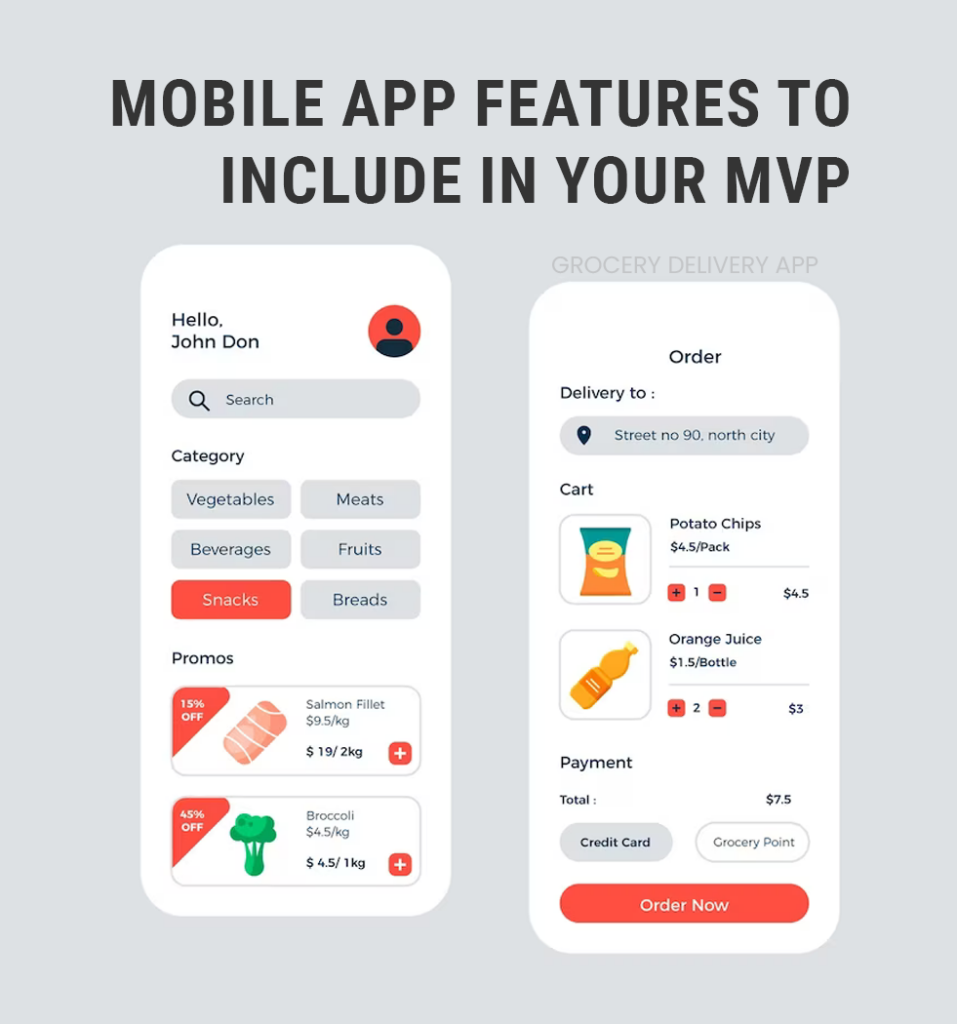
A Fast and Easy Sign-Up Process
One way to make it fast is by letting users log in with their social media accounts. If you want to welcome new users with a tutorial, make sure they can choose to skip it because they might not always have time for it.
After that, they end up in the main section of the app – the online shelves. Let’s see what we have here:
Catalog
A catalog that is separated into different sections and shows products clearly. A clear layout helps people find what they need without getting frustrated, and detailed product information helps them make good choices.
Filter Search
Not everyone will be happy with a well-organized catalog. Some people like to use the search bar to find what they need quickly. There must be various options to filter the products such as, price, ingredients, purpose.
Review and Ratings
Because customers can’t see, smell, or feel the product in person, they may be more hesitant to shop online compared to in a store. One way to build trust is to ask users to give feedback on a product they bought. They can describe their experience and give it a rating.
Shopping Cart
A basket for holding items while shopping. Nothing new here, just make sure it’s easy to manage items, like changing how many there are or getting rid of them completely. It must show how many products have been added till now, even better if it shows what those products are.
Alright, the cart is full of items, and it’s time to go to the checkout. The important features to focus here are:
Checkout Process
It is one of the most important things on this list. A long and complicated checkout always leads to fewer people buying things. When customers want to buy from you, make it easy for them to pay. You can make this step better by giving people more ways to pay.
Scheduling Delivery
Getting something right away is great, but it’s not always the easiest choice. Letting people choose when to order their groceries adds some different options and makes the app feel more personalized.
Order Status and Tracking
After the customer finishes paying, their money disappears without any immediate explanation. To make them feel less worried and uncertain, give them all the details about the order and where it is. People like it when an app sends them push notifications too.
Make sure to include the user profile screen with the user’s payment information, address, and contact details for using the app.
Phases of Developing a Delivery App for Groceries
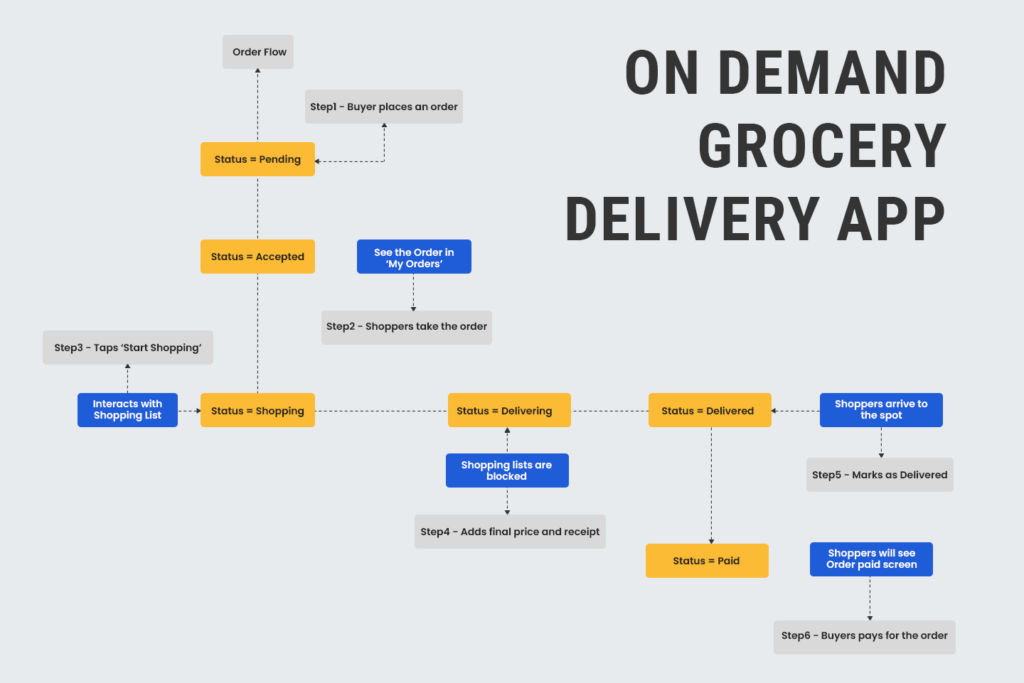
So, you have a good understanding of what your app should have. But how do you make them work? Let’s talk about the important steps for making a grocery delivery app that meets the demands of what people want now.
Discovery
The aim of the discovery phase is to start off the on-demand grocery delivery app development in the right way. It makes sure that everyone understands the project’s goals and possible problems.
During this stage, people work together to figure out who will use the product, study other companies, and decide what the product should be able to do. The main things we do in the discovery phase are:
- Doing research on what people buy and like
- Making personas of users
- Mapping the steps that users take
- Describing what needs to be done to meet the needs of the project
- Creating a roadmap for the project
By exploring these activities, the people involved can decide the best way for the app to meet the needs of both users and the business.
UI/UX Design and Delivery
This stage has two parts: making the design for the user interface and user experience, and delivering the design. When designing for Android & iOS, designers make the app look good, decide what features to include, and create sample screens.
This includes how the app looks and how easy it is to use. The decisions the team makes when designing the app will determine if people will use the app for a long time or just for a few seconds.
So it’s important to use the best design for the app to make it more likely to succeed. For apps that deliver groceries, our experts suggest focusing on making it easy to find things, showing off the products, getting people to use the app, and making sure it’s secure.
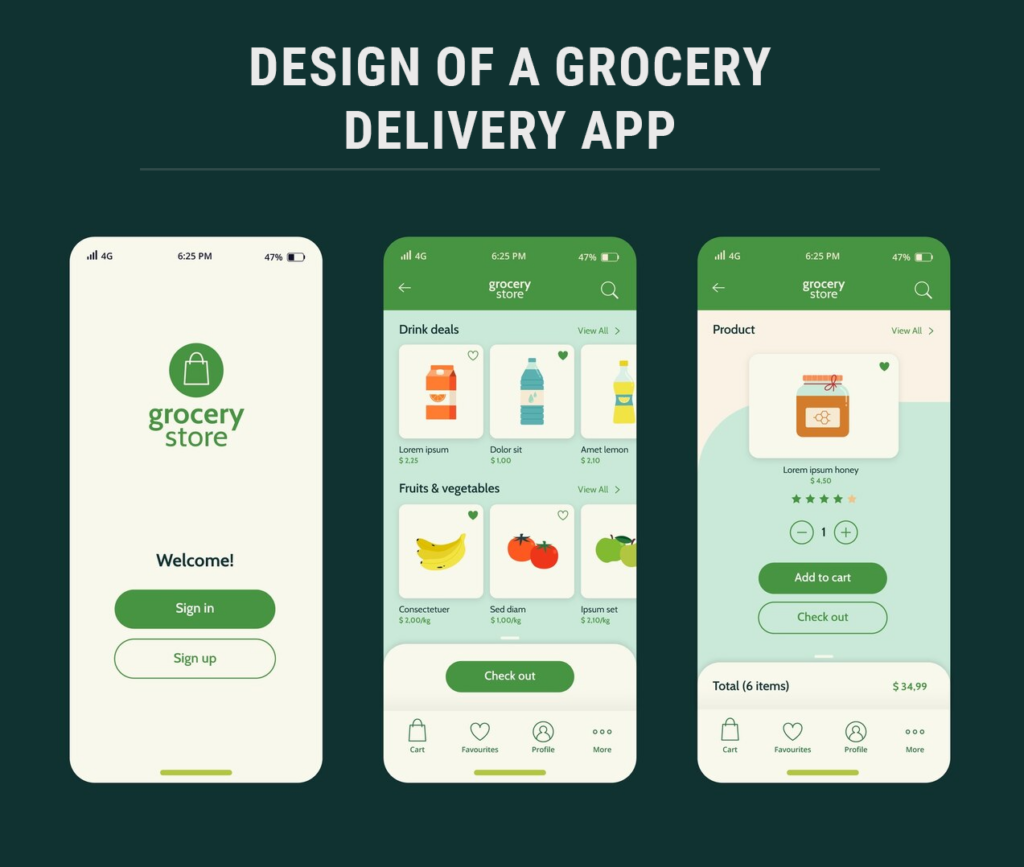
Next is when we give the final design to the development team. This means detailed designs, guidelines for how things should look, and instructions for how they should be made.
Designers and developers need to work closely together to discuss design features, how they work, and make sure everyone understands the design plan. The design delivery process makes sure that the idea becomes a real product without any problems.
Technical Development
Once the design is finished, it’s time to turn the mockups into code and create a grocery app. In the on-demand grocery delivery app development stage, the team works on making the app work well on iPhones and Android phones. They make sure the app is compatible and runs smoothly on both types of devices.
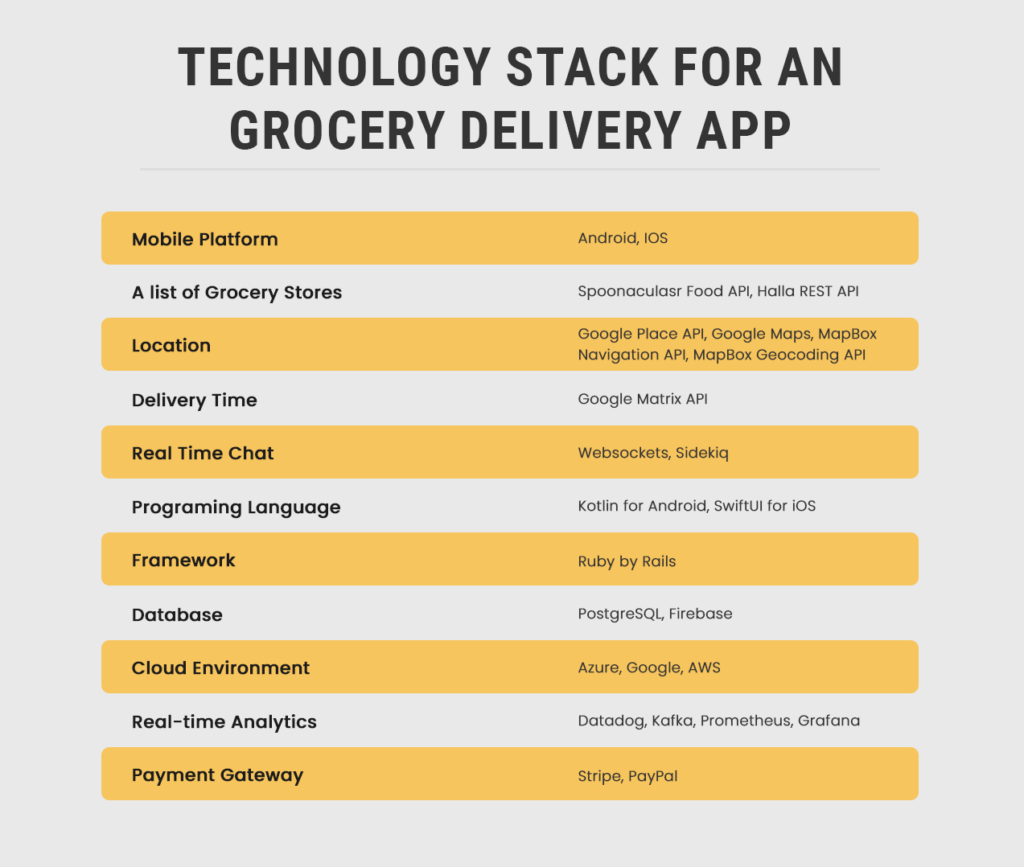
Programmers use Swift for Apple devices and Kotlin or Java for Android to make a grocery app for phones. They put in the final look, features, and how it works. This step is important because it turns the ideas and designs into a working mobile app that works well on different devices.
Another important thing is figuring out how to add the features you want to the app. This is what mobile app architecture is used for. In simple words, it is a collection of building blocks and methods used to create a program.
Testing and Improving
The last thing we do before launching is to test and improve the application. We check for any problems and make it work better. This process tests the app with both people and software to make sure it works well on different types of devices and situations.
The tech team can also test the product with users to get their feedback and make changes if needed. This stage is really important because it helps the app work better and makes users happier.
Team Structure and Cost for Developing a Grocery App
If you need help from a company to make an app for Apple and Android phones, this is the team you should hire.
- 1 person who oversees a project
- 1-2 Android app creators
- 1-2 iOS app developers
- 1-2 user interface and user experience designers
- 1 backend developer
- 2 quality analysis specialists
If you hire freelance grocery delivery app developers, you don’t need to hire a project manager. However, we think that project managers are very important in making sure everything works well, and their ideas in creating the app are very necessary.
Now that we have talked about the features and you know how to make a grocery app, let’s try to figure out how much it will cost to develop the grocery app. The cost of making an app can vary based on different things like how complicated the app is and who you hire to make it.
But we can give you a general idea of the cost for the main features. Creating a grocery delivery app takes time, especially if you have a small team. It also depends on the design and features you want for the app.
If you choose to work with the team we talked about before, we think it will take about 2366 hours of work. How expensive is it to make an app for this scenario? We have the answer in the below table.
| Phase | No. of Hours | Cost ($) |
| Discovery | 120+ | 5400+ |
| Project management | 160-200 | 7200-9000 |
| UI and UX | 130-190 | 5850-8550 |
| Android | 600-800 | 27720-36000 |
| iOS | 600-800 | 27000-36000 |
| Admin panel | 80+ | 3600+ |
| Backend | 480+ | 21600+ |
| Testing and improving | 180 | 8100 |
| Total | 2350-2850 | 105750-128250 |
The on-demand grocery app will cost around $105,750 to start with, and the price will increase depending on what features and technologies are used.
Grocery App Features for Your MVP Version
An online delivery service usually has two apps – one for customers and another for the delivery people. When a person buys something using an app, a delivery person nearby sees the order, agrees to it, and then delivers the items to the buyer.
Because grocery delivery apps are not very new or different, it would be a waste of money to launch a new one without doing research and getting ready first. Before you start making a grocery delivery app, you and your tech company should think about your idea and what makes it special.
Next is a MVP, which means the minimum viable product that can be made. Sometimes, a basic version of the app is made quickly and inexpensively to get feedback from a small group of users and make the app better.
When creating an MVP, developers work on the basic parts of the app first, without worrying about extra features and how it looks. Here are the important things to include in the MVP version of our new grocery app.
| Customer App | Delivery Person App | Admin Panel |
| List of stores | Profile | List of stores |
| User profile | Notification for delivery request | Customer info |
| Items in stock | Accept/reject delivery request | Items in stock |
| Cart page | Map | Order management |
| Order status | Products and delivery addresses | Profit |
| Payment gateway | In-app chat and calls | Analytics |
| Notifications | Earnings dashboard | |
| Order history | Payment transfer |
The customer and delivery person need to talk to each other quickly to make sure deliveries are made on time. To make sure that both these apps can communicate with each other, you will need WebSocket APIs on the backend of your software.
We like the idea of creating a product that people will really love, instead of just making the simplest version possible. Creating it means that your app will have a special feature that sets it apart from other grocery delivery apps.
Adding more features to the online grocery mobile app will make it more expensive, but it can also make your app stand out and be noticed by more people. Here are some ideas about what these features could be:
Social connectivity: Let your customers join using Facebook or sign up with their email without having to go through a registration process. This will help your customers sign up faster and easier, so they will be more likely to use your app and stay on it longer.
Shopping lists: This feature helps make shopping lists for you by looking at the things you bought before, what you need now, and what events are coming up. This makes planning easier.
Alternative options: Customers can choose a replacement item if the original item is not available. This will make it easier for users because there will be less incomplete orders.
Chatbot: It can give your customers and delivery workers important information about the products and stores, offer popular recipes for specific items, and more. Additionally, the chatbot can be improved with AI to choose very useful information for the users.
Voice recognition: Your customers will really like this because it will make it easier for them to order things while they are busy. They won’t have to stop and type in a product name or look through a store’s inventory.
Call and chat support: This could be the support for using an app or the chance to talk to a delivery person to change an order at the last minute. Also, make sure that if there is a problem with the delivery or the products, the customers get a fast and useful reply.
Reordering: Another helpful feature for busy customers is the choice to buy the same things again. This way, they can make a list of groceries once and then buy the same things again and again.
Customer loyalty programs: These are reward systems offered by companies to encourage customers to continue buying from them. Discounts and rewards like coupons, special sales, free shipping codes, and gifts are all ways to entice your customers to return to your app.
Environment friendly packaging: For people who care about the environment, being able to pick eco-friendly delivery packaging can make a big difference.
GPS-tracking: This feature will help both customers who want to know where their order is and delivery people who need to find the best way to deliver it.
Monetization of Grocery App
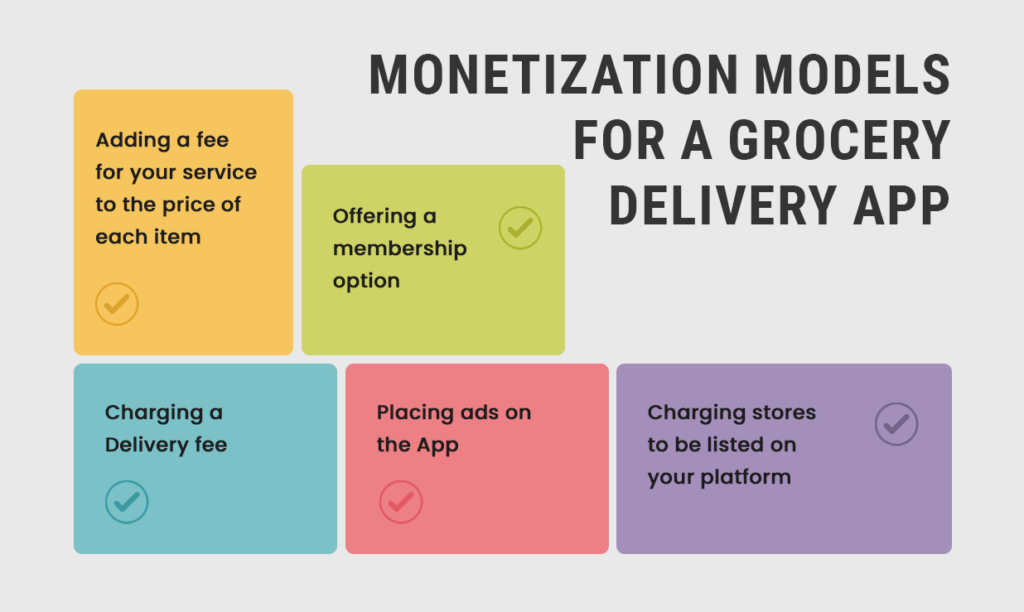
When you want to develop a grocery app, you have to figure out how to make money out of it. Creating a high level app is expensive, and you will also have to pay the delivery people. Moreover, you started a business to earn money, correct.
If you own a store and are thinking about making an app to grow your business, you will make money by selling more products. An app can help you save money over time. Let’s say there are some products that haven’t sold as well as you thought they would.
You can offer them at a sale price before they expire and tell your customers about it with a notification. In general, a mobile app is a great way to tell people about special offers, talk to customers, and make them want to keep coming back.
If your business is just about delivering things, there are many ways for the owners of grocery delivery apps to make money. Some of the ways to make money out of your grocery delivery app are:
Charging a Service Fee on Top of the Price of Each Item
You can make the price of each item a bit more expensive than it is in the store. If you do this, you need to make sure your users know about the higher prices. This will show that you are being honest and open. Add a message that appears the first time customers buy something or look at the products. Additionally, don’t forget to add a reminder in your policy.
Charging a Fee for Delivery
This is the most popular way to make money. Your customers pay for the products at the store’s prices and also pay for delivery. Depending on how many things need to be delivered and how far away the customer is, the person delivering might use a car or public transport to get there.
You can choose a starting price and add a feature to figure out the final price without needing to do it yourself. Also, you can raise the delivery fee during busy times, called surge pricing.
Through Ads
This way of making money is used by many businesses. Many apps have ads to help pay for the costs and make their services cheaper for users, which makes some people happy and others not so much.
Charging Shops to be Included on Your App
If lots of people use your app, you can ask shops to pay each month to sell their products on it. Stores will get more people to know their brand and come and shop directly in their physical stores.
Charging With Membership
Some apps for delivering groceries offer a choice to pay every month or every year for a membership. Customers get free deliveries when they order, and they don’t have to pay extra fees when shopping in different stores in one order. You can choose one way to make money from your product or combine different ways.
Challenges in Developing an App for Grocery Delivery
Logistics Management
Creating a grocery delivery app comes with many challenges in managing the supply chain and logistics. One big problem is making sure that perishable items are delivered on time and in good condition.
Organizing deliveries from many grocery stores or vendors to different places makes it harder to plan the best routes and schedules. Keeping track of how much stuff you have and making sure you have enough to meet changing demand needs a strong system for managing how things move from one place to another.
Overcoming these problems means using smart plans for delivering products, tracking where things are in real time, and running warehouses well to make sure orders are filled and sent out smoothly.
User Interface and Experience
Designing an easy-to-use interface for a grocery delivery app is hard. The app should be able to work well with many different products and categories, and make it easy for people to find and look at things.
It’s important to make things simple and easy to use so that people can find what they want and buy it easily. Furthermore, adding search options, personalized suggestions, and different ways to pay makes the user interface more complicated.
Creating a good-looking and adaptable interface for different users and devices needs careful planning, testing with users, and making improvements based on feedback.
Third-Party System Integrations
Connecting a grocery delivery app with different third-party systems has its own challenges. These systems could be payment systems, software for keeping track of inventory, services that locate things using GPS, and platforms for talking to others.
Making sure that different systems can communicate with each other and share information without any problems, while also keeping it all safe and following the rules, can be hard. Problems like compatibility issues, API limits, and data syncing challenges can happen when we put things together. We need to test and fix these problems carefully.
Also, keeping track of and updating other systems can make maintenance more difficult and increase the chances of system problems. Overcoming these challenges means carefully making an app business plan, working with other companies, and continually checking and improving how things are connected.
Quality Assurance
Making sure the grocery delivery app works well and is safe involves testing it thoroughly for quality and performance. Trying out the app on different kinds of devices, operating systems, and network conditions to make sure it works well is a big job.
Making sure that product information, prices, and stock levels are correct in real-time needs careful testing of the systems and data that support them. Checking for quality of the products must be done more often since these products are prone to perish easily.
Testing for security is really important to find and fix problems with data breaches or payment fraud. Using tools to test the app and checking it regularly can make the testing process faster and make sure the app is good quality.
Customer Expectations
Satisfying customers by delivering groceries on time, providing good quality products, and excellent customer service is very important in the grocery delivery business. To handle busy times like holidays and weekends, you need to plan carefully and make sure you have enough staff and resources so that things run smoothly and there are no service problems.
Dealing with customer questions, complaints, and changes to orders makes things more complicated. Using feedback forms, asking customers how they feel, and communicating with them in advance can make customers happier and improve the service they receive.
Making sure that the quality of service is the same in all places, with delivery partners, and at the places where things are sent from, needs good communication, training, and checking how well people are doing their job.
Final Thoughts
The grocery delivery app has changed the way people buy groceries. These grocery delivery apps make shopping convenient for people who want to buy things quickly and easily. They are designed in a way to meet the changing needs of today’s shoppers.
A grocery delivery app needs to be really good at making it easy for people to order and pay for groceries, and to track their delivery. It also needs to give recommendations based on what people usually buy, to make it more convenient.
There are already many popular services that deliver groceries. However, it can still be a good idea for a business as long as you pick a skilled and reliable team to help you. With new ideas and smart spending, grocery delivery services will keep changing how we shop for food, helping people to make better choices and live a better life.
FAQs
What should be the main features in a grocery delivery app?
The main features in an app for ordering groceries should let people sign up, look at products, search and filter, manage their shopping cart, pay securely, track their orders, schedule deliveries, get notifications, and ask for support.
How much time does it take to develop a grocery delivery app?
The time it takes to create a grocery delivery app can change based on how difficult it is, what features it has, which devices it works on, and how many people work on designing it. Usually, it can take from a few months to a year to develop a complete and smooth app.
What kind of technology is usually used to make a grocery delivery app?
The technology used in grocery delivery app development includes programming languages like Swift or Kotlin for making native apps, and JavaScript frameworks like React Native for making apps that work on different types of devices. Backend development usually uses technologies like Node.js, Express.js, and databases like MongoDB or PostgreSQL.
How do I make sure that the customer’s information is safe in the grocery delivery app?
To keep customer information safe in a grocery app, you need to use strong security measures like HTTPS, secure logins, and data encryption. You also need to do regular checks to make sure everything is secure and follow data protection laws.

